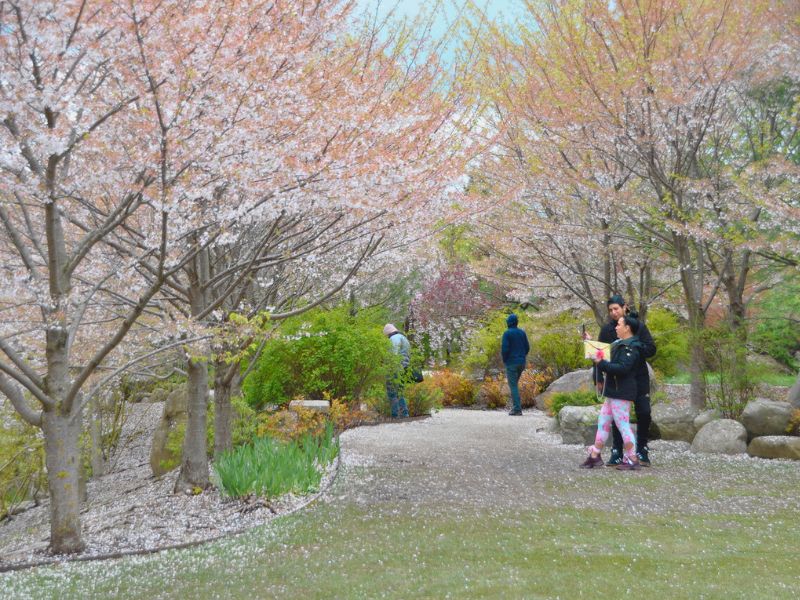Discover the Japanese Garden at Meijer Gardens in Michigan
The Japanese Garden at Frederik Meijer Gardens & Sculpture Park in Grand Rapids, MI offers a chance to experience the beauty and serenity of a traditional Japanese garden in a lovely setting.
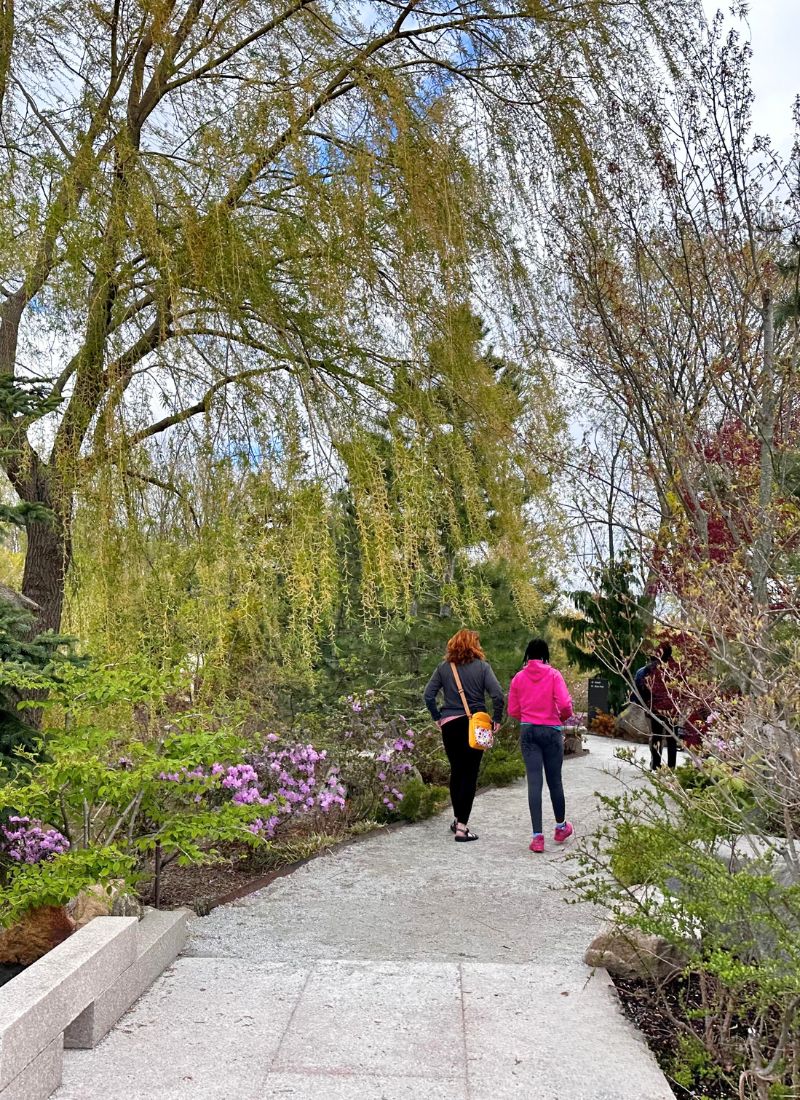
Filled with the elements expected in a Japanese garden, a visit to this garden is a great way to learn about Japanese culture and art and a perfect place to relax and reflect.
There is even a magical grove of cherry trees with spring cherry blossoms!
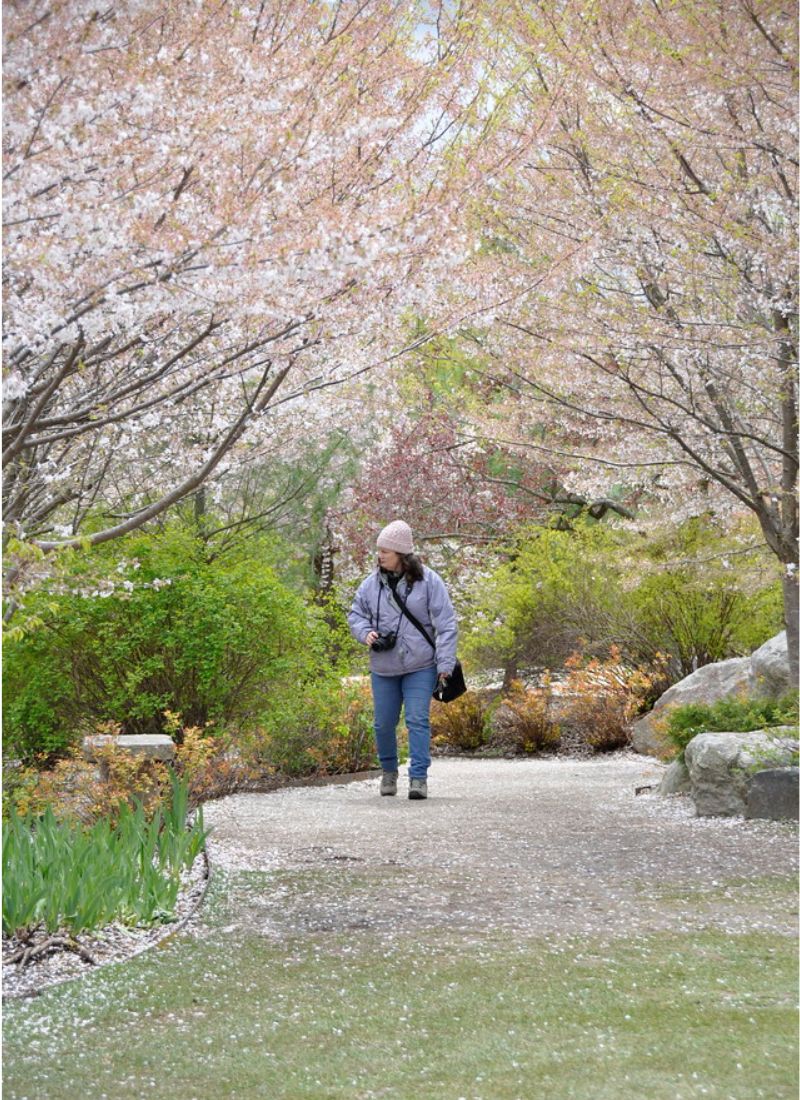
Take a look at what you can expect on your visit:
Self-Guided Walking Tour
Main Walking Loop – 0.6 miles
When life needs a reset, it’s time to stroll through the beautiful scenery of the Japanese Garden.
The main walking path at the garden is just over a half-file long. Short trail spurs and meandering stepping stone pathways will lure you to gazebos and bridges and waterfalls.
If you hurry, you can walk the loop in 10-15 minutes. But you won’t want to hurry.
This peaceful oasis, filled with year-round natural beauty, invites you to linger. Plan to spend 45-60 minutes in this garden if you want to soak up all it has to offer.
Elements worth noting on your tour are listed below as well as outlined on the map.
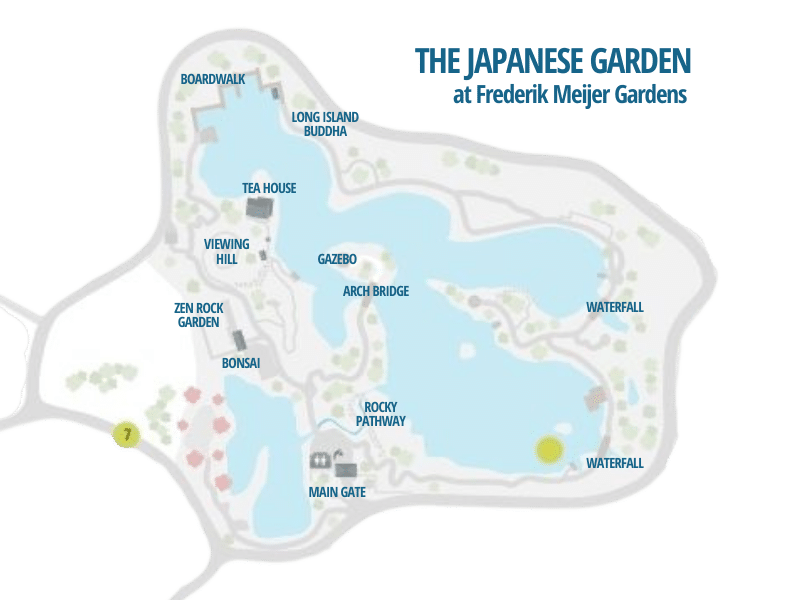
Bonsai Garden
Displayed outside the Zen garden from May-November, you’ll delight in each tiny detail of the shrubs and trees in the Japanese garden’s extensive bonsai collection.
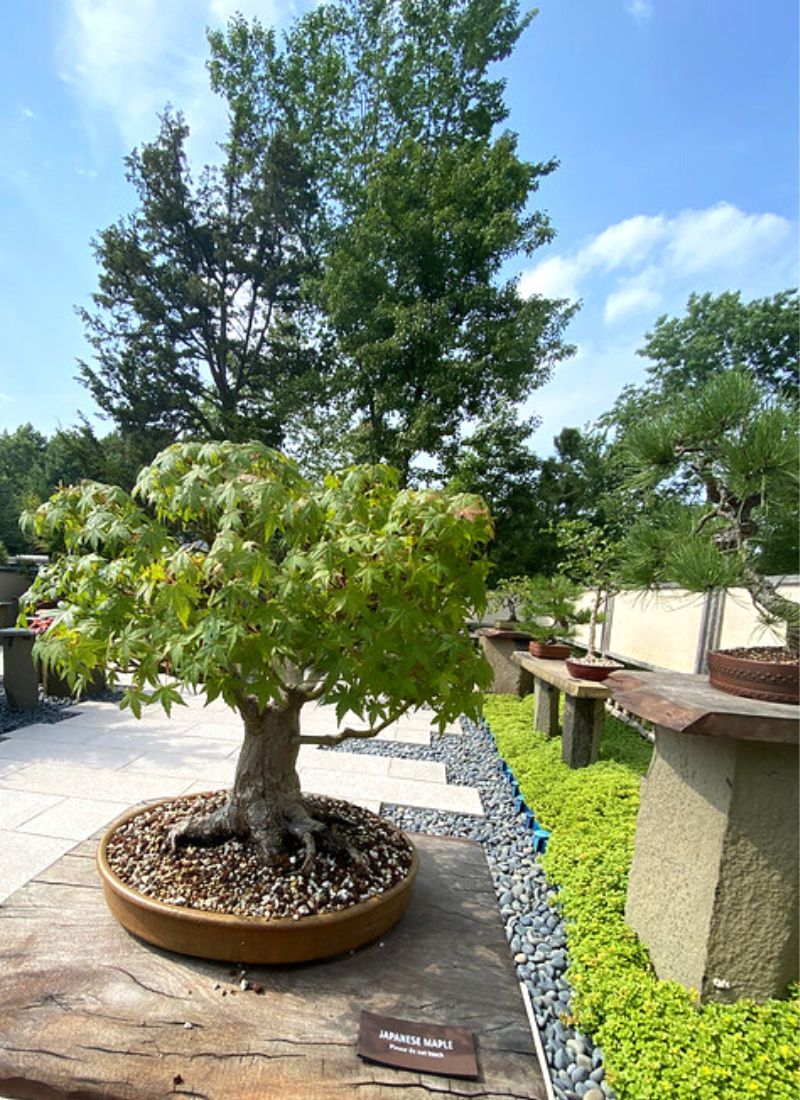
These impressive mini-trees are truly works of art!
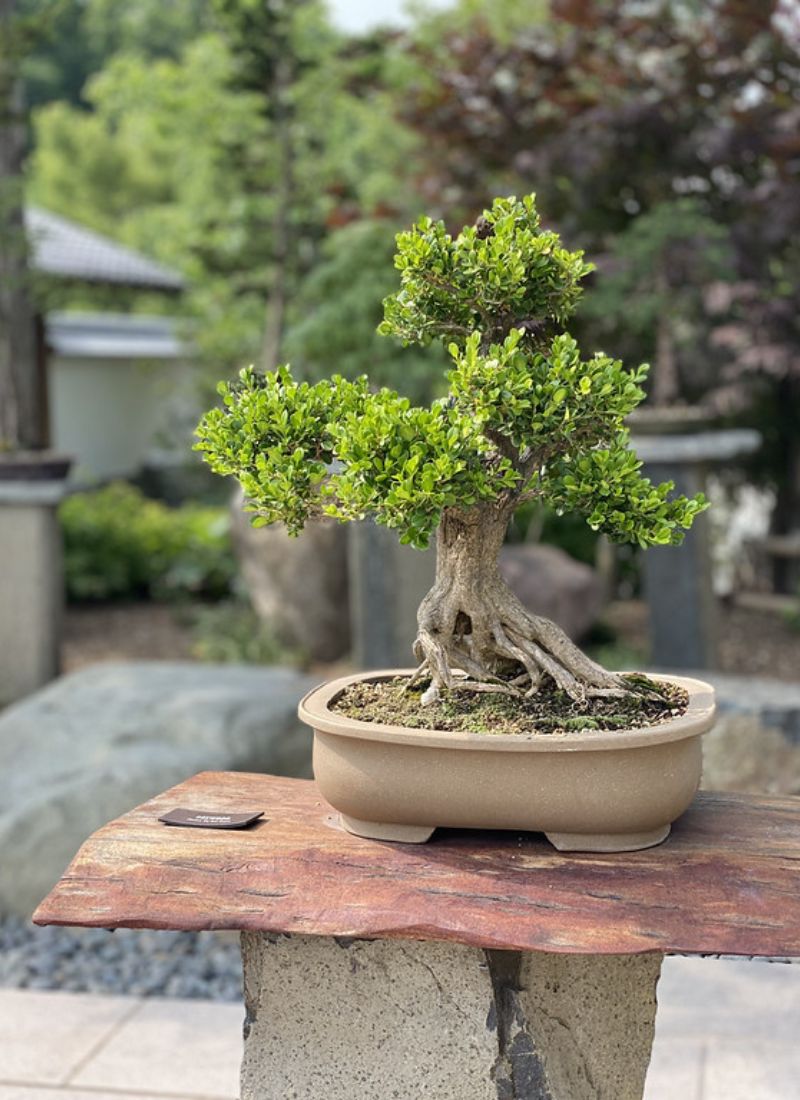
Meijer Gardens Cherry Blossoms
Set apart from the main garden loop, a spectacular grove of cherry trees lights up with stunning blooms in the spring.
A ribbon of velvety green grass weaves through the grove under pink and white blossoms, ending at secluded benches by the water.
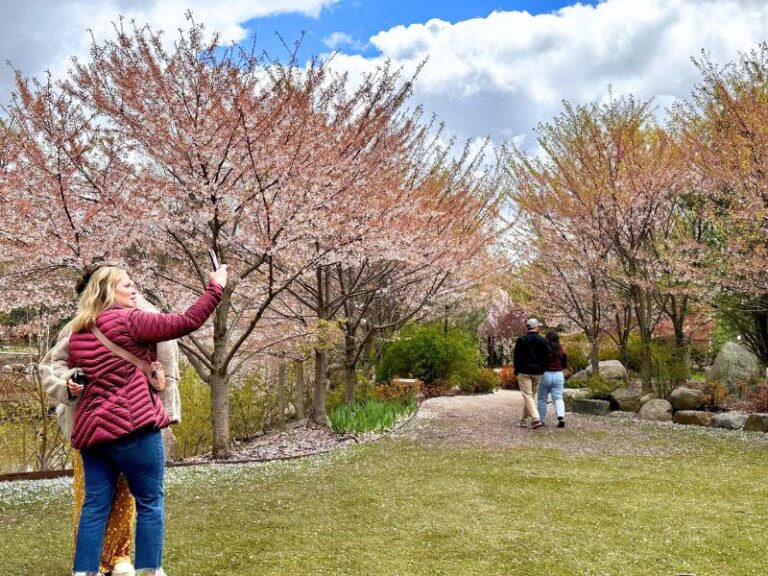
The cherry tree promenade requires a bit of extra effort to find (look for the trail spur at the Japanese Garden’s main gate). You’ll also need a bit of good luck when it comes to timing your visit to match the blooms, but it’s completely worth the effort.
Benches, a green grass carpet, and a waterfall backdrop complete the scene. It’s a photo dream spot!
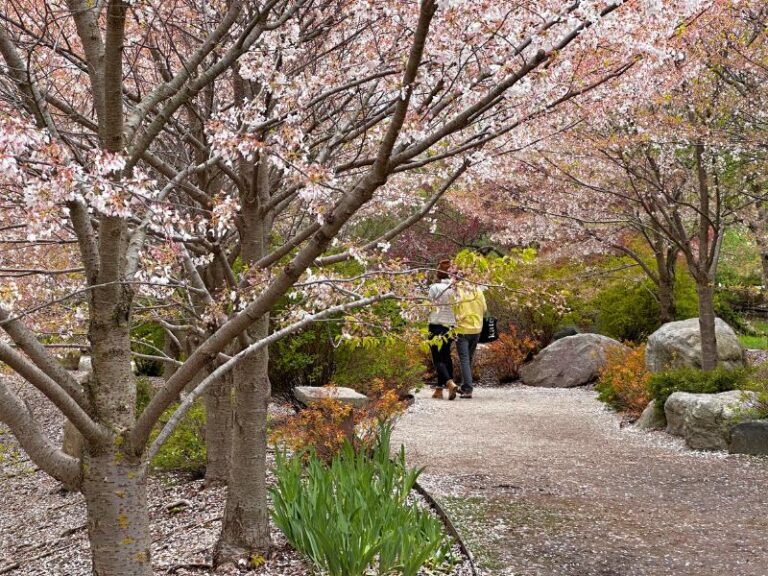
Everyone wants to know: When do the cherry blossoms bloom?
Typically, the cherry blossoms are popping in mid-April, but that can be earlier or later depending on that spring’s weather.
Main Gate
Leave the world behind when you step through the Japanese Garden’s Main Gate. Its impressive architectural features invoke serenity and peace.
From here, one suggestion is to traverse the garden counterclockwise through various stations.
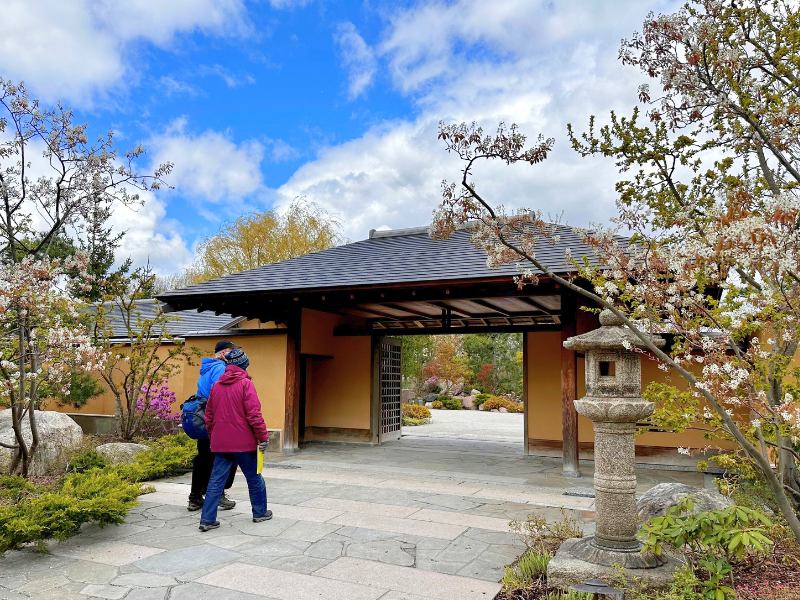
Viewing Hill & Tea House
Wind your way to the top of the Viewing Hill. Trust me – you don’t want to miss this stunning view of the garden.
The spiral pathway up allows a look at the garden from all angles.
Catch a glimpse of the Japanese teahouse just below the hill. This beautiful and authentic structure was made in Japan, shipped, and reassembled at FMG.
Go inside and take part in a traditional Japanese tea ceremony (performed by Japanese tea masters in kimono!) when you visit on the third Saturday of the month (May-October).
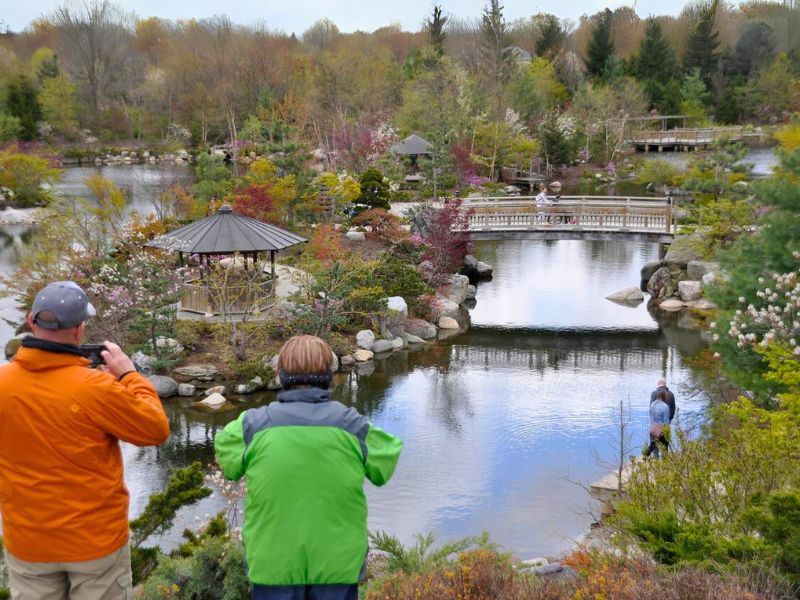
Zen Rock Garden
Here, the placement of the rocks and boulders invites quiet contemplation, inviting you to meditate in the Zen-style garden.
(I love how the gravel patterns are raked to reflect the seasons.)
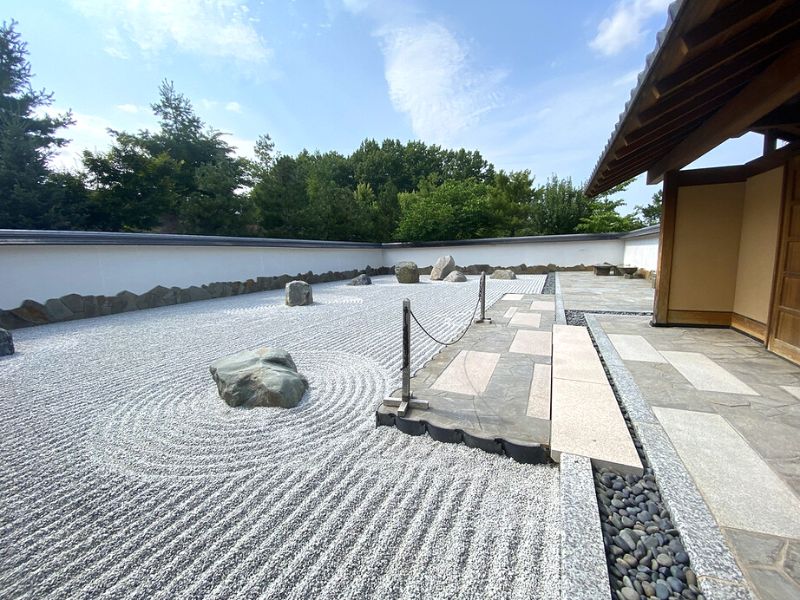
From here, zig-zag your way down the winding paths overlooking the Lena Meijer pond. Sit at one of the many benches you find along the way. Bring a book or just savor the views.
The Island Gazebo & Arch Bridge
The center of it all, the Island Gazebo is the focal point of the garden from almost every vantage point. Cross the wooden arch bridge to reach the island gazebo in the Japanese Garden.
Well-placed benches invite you to relax and take in the beauty of the surrounding garden.
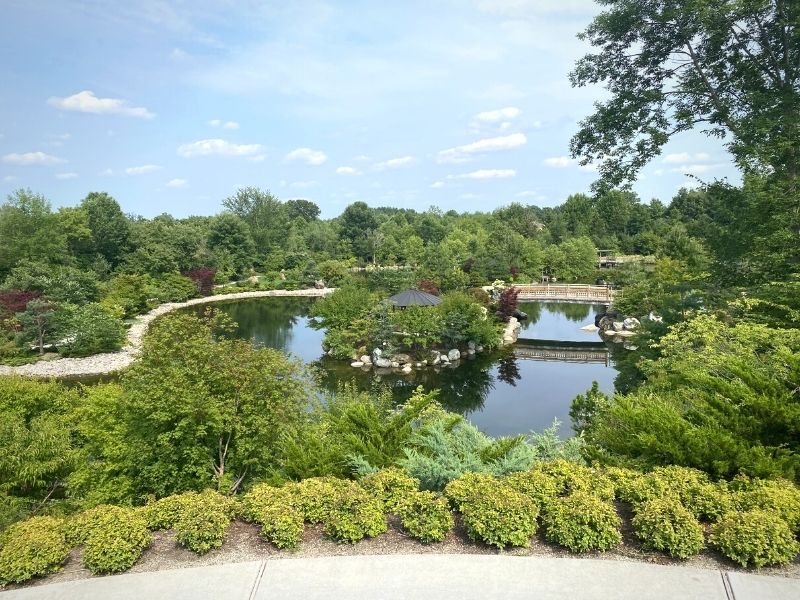
Meander Down the Peninsula Path to the Gazebo
The crushed gravel pathway twists and turns as it winds its way to another gazebo, this time crowning the point of the peninsula path.
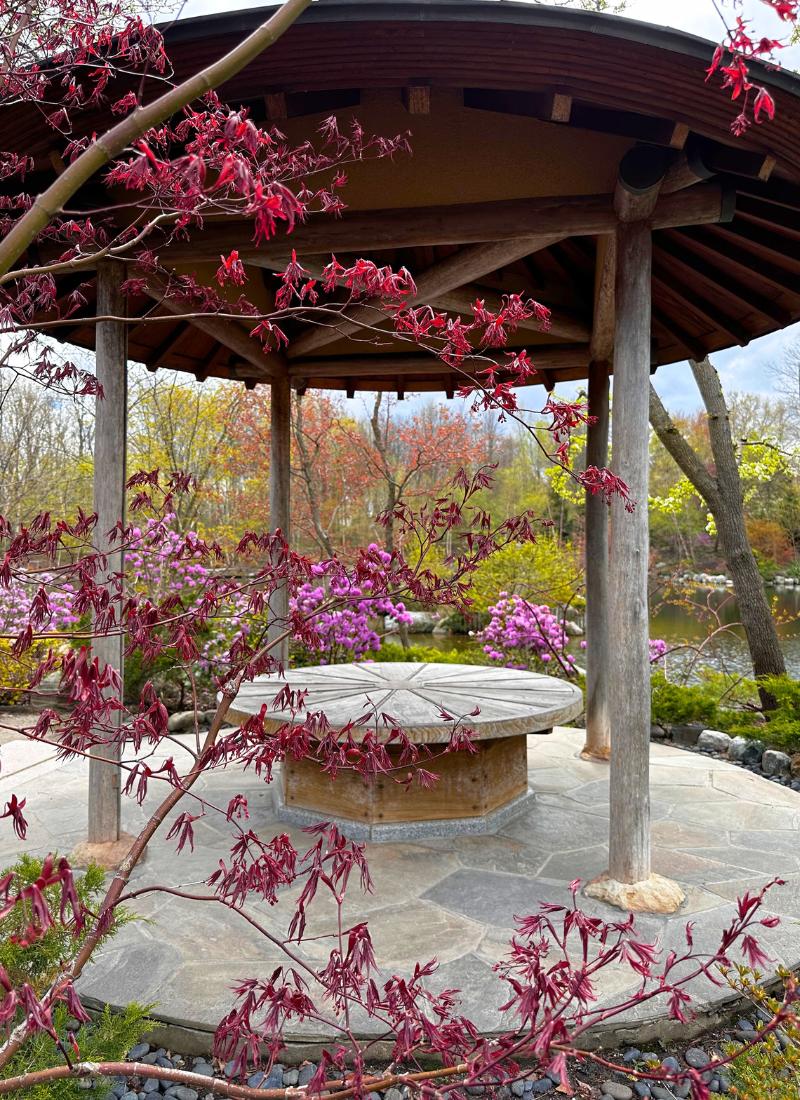
Zig-Zag Boardwalk & Thoughtful Pathways
Get another look at the cherry trees and then wind your way through rocky pathways, across zig-zag boardwalks or over bridges.
Each element invites contemplation and elevates awareness of surroundings.
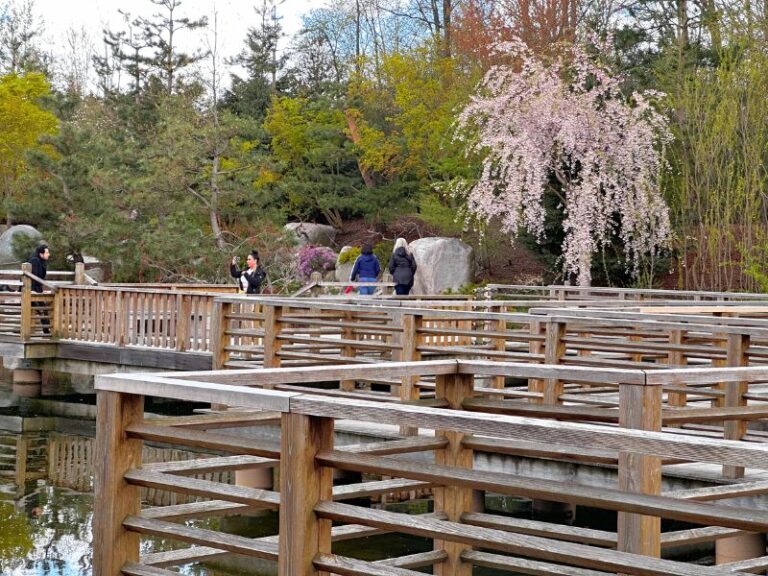
Most pathways are hard-packed or paved and are accessible, with the exception of several stepping stone trails.
Stepping Stone Pathway
At one point, a stepping stone path winds its way through the Japanese garden, following and crossing a small stream along the way.
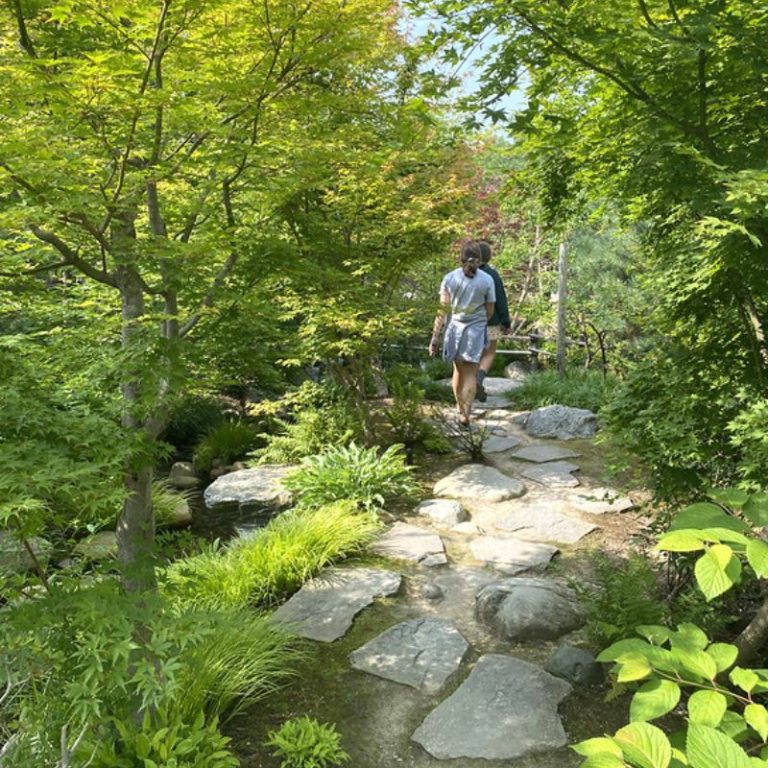
Find the Waterfalls
The four small waterfalls are a popular feature, adding the peaceful sound of water trickling down rocks to the garden.
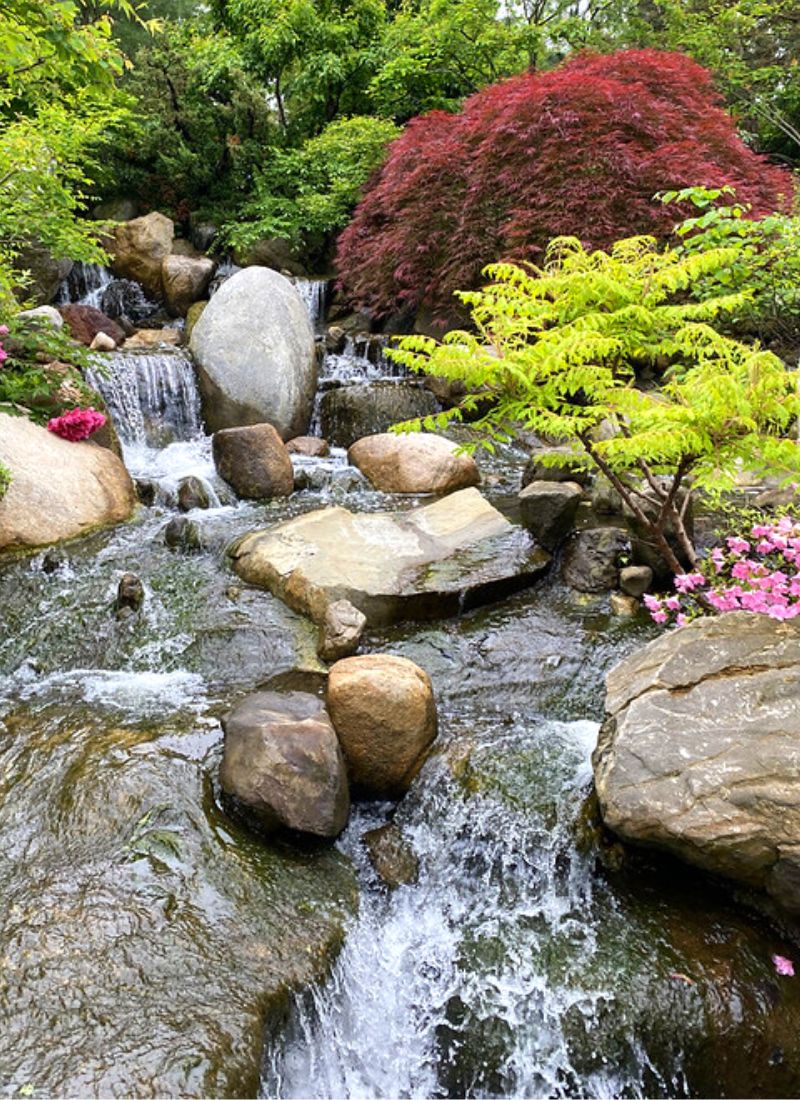
Sculptures in the Japanese Garden
You’ll also encounter well-placed, thought-provoking sculptures as you stroll through the garden.
Here are a few to look for:
Long Island Buddha – appears ancient to reflect on violence and its destruction of culture
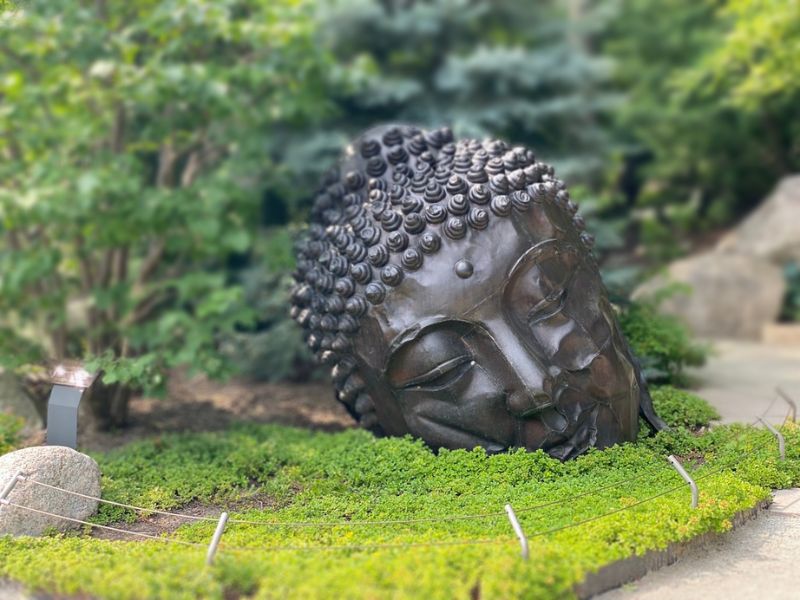
For the Garden – Japanese poems engraved on the surface of 13 boulders
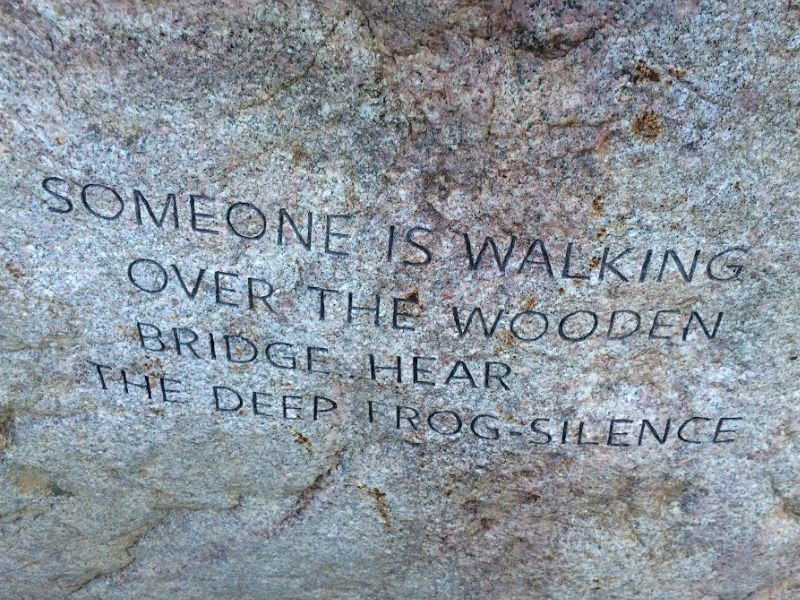
Existence – a five-part granite sculpture placed in a sea of grass
Untitled by Anish Kapoor – a large granite carving that reflects the viewer and your surroundings
Visit in Every Season
Appreciate something new and beautiful at the Japanese garden throughout the year.
Catch the famous Japanese cherry trees in bloom in the spring. The beautiful pink and white blossoms are a sight to behold.
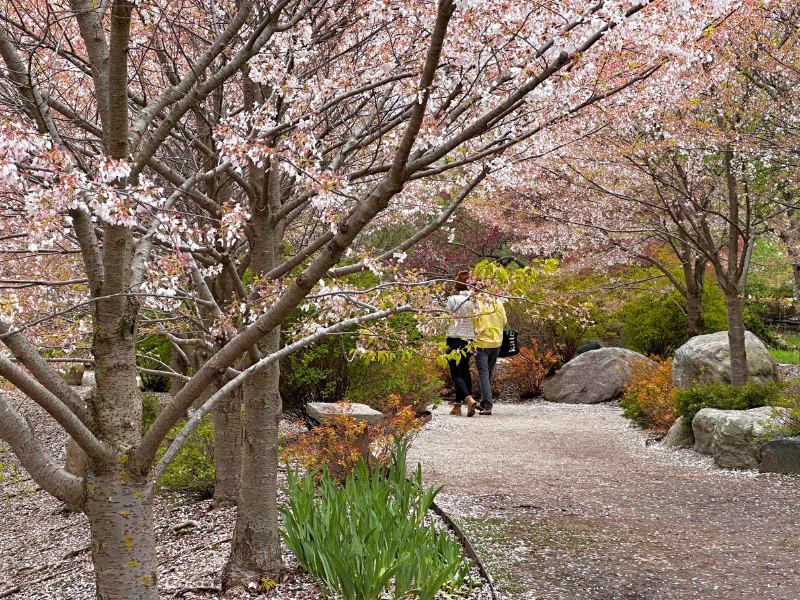
The Garden is lush and full of life in the summer. Spot turtles and fish swimming in the pond.
Peep classic red, orange, and yellow hues on display in the fall.
Notice the variety of colors and leaf shapes on the Japanese maples. Spot the native-to-Michigan serviceberry with leaves that turn a beautiful red-orange color.
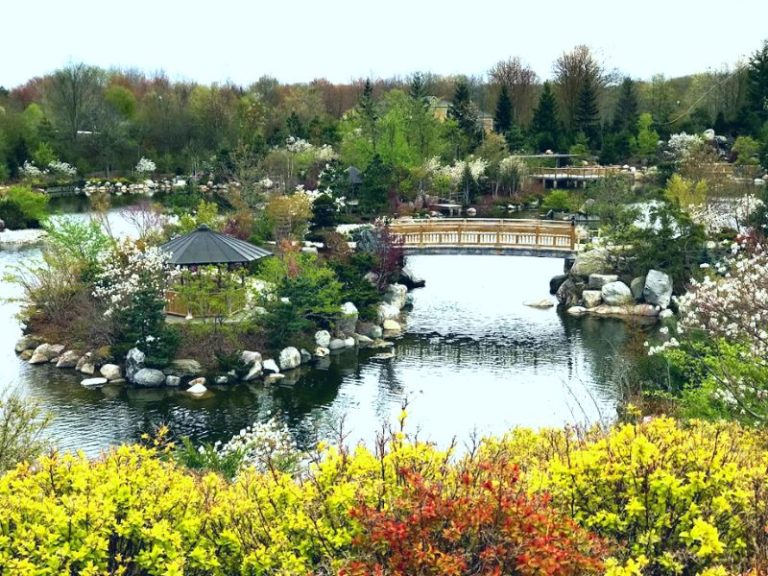
Become enchanted with the garden in the winter months.
This is actually my favorite time to visit! The snow-topped evergreens are the perfect backdrop for a peaceful winter stroll.
Meijer Gardens Tickets & Admission
Frederik Meijer Gardens & Sculpture Park – 1000 E Beltline Ave NE, Grand Rapids, MI
Entrance to the Japanese Garden at Frederik Meijer Gardens is included with regular admission.
Frederik Meijer Gardens and Sculpture Park is open 362 days a year.
Closed on Thanksgiving, Christmas Day, and New Year’s Day.
Regular open hours:
9 AM – 5 PM Monday – Saturday
11 AM – 5 PM Sunday
2025 Admission Rates
$22/adults
$17/seniors
$16/students
$11/kids 3-13
Kids two and under are free
Memberships are available
Tickets may be purchased at the admission desk or online.
The Meijer Garden Japanese Garden in Michigan is Special
If you like Japanese Gardens, this one must be on your list.
Its authenticity is unmatched; it’s like stepping into a piece of Japan with its koi ponds, tea house, and bonsai and Zen garden.
And no matter when you visit, there’s always something different to see, from cherry blossoms in spring to vibrant fall colors.
Plus, everyone can enjoy it – they’ve made sure of that with ramps and wide, accessible paths. It’s a special place through and through.
So, when you need some peace (who doesn’t right about now?) head to the Japanese Garden at FMG and discover something new. Let us know what you thought about your visit to the garden!
Japanese Garden FAQs
How did the Japanese Garden at Frederik Meijer Gardens come about?
Fred and Lena Meijer spearheaded the effort to bring the garden to FMG, which opened its doors in 2015.
Master garden designer Hoichi Kurisu transformed a marsh and wooded area of FMG into the Richard & Helen DeVos Japanese Garden. The Japanese Garden was designed by a team of Japanese garden experts, who worked to create an authentic Japanese garden experience. The garden features traditional elements such as a koi pond, a tea house, and a Zen garden, among other things.
Does the FMG Japanese Garden host events?
Meijer Gardens periodically offers educational programs and workshops that focus on different aspects of Japanese culture, such as tea ceremonies, calligraphy, and bonsai. This is a great way to learn about Japanese culture, art, and history.
Is the FMG Japanese Garden accessible?
Yes. The garden is accessible to all visitors and has ramps, wide paths, and other features that make it easy for visitors with mobility issues to enjoy most features of the garden.
What makes a garden a Japanese garden?
A Japanese garden sets itself apart from other gardens by highlighting the natural landscape and focusing on Japanese aesthetics.
Known for their careful design with rocks, water, and plants, these gardens change with the seasons.
Above all, a Japanese garden is a natural and simple space that allows for quiet contemplation.
Are there other Japanese gardens in the U.S.?
Yes! There are many Japanese gardens in the U.S.
The Japanese Tea Garden in Golden Gate Park in San Francisco is the oldest and most well-known, but there are several notable Japanese gardens right here in the Midwest.
Take a peek at the list at the end of this article.
Can you visit a Japanese garden in the winter?
Yes – A Japanese garden is designed to adapt with the seasons and it’s fascinating to see how it changes in winter compared to popular spring and summertime visits.
There are trees and plants in a Japanese garden that thrive in the winter, such as bamboo, moss, and evergreens. The rock and water elements provide interesting viewing throughout the year.
More Japanese Gardens to Visit
If you like the Japanese Garden in Grand Rapids, you might want to add more to your list.
No two Japanese gardens are alike and chances are, once you visit one, you’ll want to visit another.
Add a Japanese garden experience to your travels when you’re looking for a quiet place to unwind or have some alone time in nature. Or make a special trip to see one!
Many significant Japanese gardens can be found here in the U.S., and beyond. Each one has something unique to offer.
In Michigan:
Cranbrook Japanese Gardens in Bloomfield Hills features an iconic vermillion Japanese-style bridge – a part of the Cranbrook landscape since 1914. 380 Lone Pine Rd, Bloomfield Hills, MI
Japanese Cultural Center, Tea House and Gardens of Saginaw has one of the most authentic tea houses in North America. The type of tea ceremony performed here dates back to 1600 AD. 527 Ezra Rust Dr, Saginaw, MI
Shigematzu Japanese Garden is one of the top attractions in downtown Lansing. 600 N Grand Ave, Lansing, MI
In the Midwest:
Chicago Park District Japanese Garden, created in 1893, has a long history celebrating the friendship between the U.S. and Japan. 6401 S Stony Island Ave, Chicago, IL
Anderson Japanese Gardens in Rockford, Illinois, is rated one of North America’s highest quality Japanese gardens. 318 Spring Creek Rd, Rockford, IL
Elizabeth Hubert Malott Japanese Garden in Glencoe, Illinois, is known for its three islands. 1000 Lake Cook Rd, Glencoe, IL
Shiojiri Niwa in Mishawaka, Indiana, symbolizes the Sister-City relationship between Mishawaka, Indiana and Shiojiri City, Nagano Prefecture, Japan. 1000 East Mishawaka Ave, Mishawaka, IN
Normandale Community College’s Japanese Garden features a Bentendo (hexagon-shaped building) and Taikobashi (drum-shaped bridge), which are gifts from WWII Nisei military veterans. 9700 France Ave S, Bloomington , MN
Mizumoto Japanese Stroll Garden is the oldest attraction at the Springfield Botanical Gardens. 2400 S Scenic, Springfield, MO

